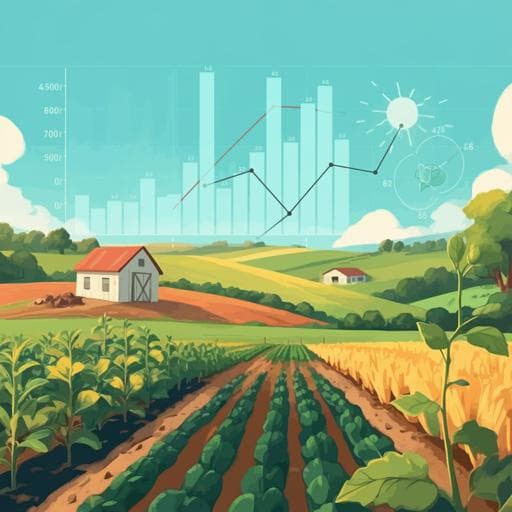
Economics
A flexible and efficient hybrid agricultural subsidy design for promoting food security and safety
Y. Chen, Z. Zhang, et al.
Explore the innovative design of a hybrid agricultural subsidy that balances food quantity and quality to enhance food security and safety, all while addressing cost uncertainties and resource constraints. This research was conducted by You-hua Chen, Zhuang Zhang, and Ashok K. Mishra.
~3 min • Beginner • English
Introduction
The paper addresses how to design an agricultural subsidy that simultaneously promotes food security (quantity) and food safety (quality). Governments frequently subsidize agriculture, often focusing on output expansion, which can encourage environmentally damaging practices. China’s policy shift toward green and high-quality agricultural development motivates reconsideration of subsidy design. The authors propose a hybrid subsidy—combining quantity- and quality-oriented components—to flexibly balance the trade-off between quantity and quality. The study formulates a theoretical model to assess the feasibility and efficiency of such a hybrid subsidy, explicitly incorporating cost uncertainties (for quantity and quality investments) and input resource constraints. The research is important because quality (safety) and quantity are interdependent in food markets, and policy effectiveness can be materially affected by uncertainties and capacity constraints prevalent in agriculture.
Literature Review
The literature reflects a long-standing debate on agricultural subsidies: they support food security and rural development but can distort markets. Countries use varied instruments (input subsidies, output subsidies, price supports; more recently decoupled payments). Few studies analyze subsidies’ effects on product quality. Prior research in other domains suggests hybrid or matching subsidies can outperform single instruments and that subsidies can shift quality choices across product tiers. Studies also show uncertainty and input constraints significantly influence firms’ decisions and subsidy efficiency. However, gaps remain: limited attention has been paid to quality-oriented subsidies in agriculture, and no comprehensive analysis considers both cost uncertainty and input resource constraints jointly in a framework that integrates quantity and quality decisions. This study fills these gaps and evaluates eight conditions spanning subsidy types, uncertainty, and input constraints.
Methodology
The study develops a microeconomic model of a representative food-producing firm under a monopoly setup to obtain analytical results, arguing that competition does not qualitatively change the main insights.
- Demand: Inverse demand links price p to quantity x and quality q: p = a + βq − x, with a > 0 and 1 < β < 2. Price decreases with quantity and increases with quality.
- Subsidy: A hybrid subsidy with intensity s (0 < s < 1) is split between quantity (ratio y) and quality (ratio 1 − y), where 0 ≤ y ≤ 1. y is taken as exogenous.
- Costs: Quadratic cost without interaction terms, c(x, q) = x^2 + q^2, ensuring convexity and tractability.
- Profit: π = (a + βq − x) x − c(x, q) + y s x + (1 − y) s q.
Cases solved analytically:
1) Hybrid subsidy (0 < y < 1): Closed-form equilibria for x, q, p as functions of a, β, s, y. Comparative statics explore how y, β, s affect outcomes.
2) Pure quality subsidy (y = 0) and 3) Pure quantity subsidy (y = 1): Closed-form equilibria provide benchmarks. Proposition 1 orders equilibrium x, q, p across these regimes, showing stimulation effects consistent with policy intent.
- Comparative statics: Proposition 2 establishes trade-offs: quantity subsidies raise x and lower q and p; quality subsidies raise q (and often p) but can reduce x. Effects of β and s are characterized, including an inverse-U relation between price and s depending on y.
- Welfare: Consumer surplus (CS), producer surplus (PS), government transfers (TS), and social welfare (SW = CS + PS − TS). Proposition 3 shows CS, PS, TS, and SW increase with y, β, and s under model assumptions; pure quantity subsidy can yield the highest SW in this framework.
Expansion analyses:
A) Input constraints: A finite input resource R implies trade-offs between x and q under three regimes:
- Equal priority (EC): x + k q = R, with 1 ≤ k ≤ 2 capturing resource conversion efficiency.
- Quantity priority (XC): prioritize meeting quantity needs first.
- Quality priority (QC): prioritize meeting quality needs first.
Analytical equilibria are derived. Proposition 4 orders outcomes: xQC < xEC < xXC, qQC < qEC < qXC, and pXC < pEC < pQC. Proposition 5 ranks welfare: CS, PS, SW are highest under XC and lowest under QC; TS ordering depends on y and k via a threshold.
B) Cost uncertainty: Introduces θ uniformly distributed on [0,1]. Two types considered separately:
- Quantity cost uncertainty: increases effective marginal cost of quantity; analytical equilibria and expectations derived.
- Quality cost uncertainty: increases effective marginal cost of quality; analytical equilibria and expectations derived.
Proposition 6: Either uncertainty type reduces equilibrium x, q, and profits; quantity cost uncertainty increases price, while quality cost uncertainty decreases price. Proposition 7: Quality cost uncertainty yields higher expected q and p than quantity cost uncertainty; comparative results for expected x, profits, and profit variance depend on β, s, and y. Policy implications are drawn from these comparative statics.
Key Findings
- Hybrid subsidy flexibility: A hybrid subsidy (splitting intensity s between quantity y and quality 1 − y) enables policymakers to trade off food quantity (security) and quality (safety). Proposition 1 shows equilibria for x, q, p lie between those under pure quantity and pure quality subsidies.
- Trade-offs and comparative statics (Proposition 2): Quantity subsidy raises x and lowers q and p; quality subsidy raises q (and often p) while potentially lowering x. Higher β (marginal price contribution of quality) and higher s tend to increase both x and q. There can be an inverse-U relationship between p and s depending on y.
- Welfare (Proposition 3): CS, PS, TS, and SW increase with y, β, and s; despite higher TS, the combined gains to CS and PS can outweigh TS, increasing SW. Within the model, pure quantity subsidy can maximize SW.
- Input constraints (Proposition 4): Under resource limits R, quantity-priority (XC) yields highest x and lowest q and p; quality-priority (QC) yields lowest x and highest q and p; equal-priority (EC) is intermediate. Policymakers should encourage EC to balance security and safety.
- Welfare under constraints (Proposition 5): CS, PS, SW are highest with XC and lowest with QC; TS rankings depend on the quantity subsidy ratio y and the resource conversion efficiency k, with threshold behavior.
- Cost uncertainty (Propositions 6–7): Any cost uncertainty reduces x, q, and profits. Quantity cost uncertainty raises p; quality cost uncertainty reduces p. Quality cost uncertainty leads to higher expected q and p than quantity cost uncertainty. Quantity cost uncertainty is more detrimental to food security and overall performance; it also tends to raise profit risk more than quality cost uncertainty. Policy should therefore focus on reducing quantity cost uncertainty.
Discussion
The model directly addresses the core policy question: how to design subsidies that jointly promote sufficient food quantity and adequate food quality. Analytical results show that a hybrid subsidy can internalize the trade-off and be tuned by adjusting the quantity share y and intensity s. Welfare analysis indicates that, while subsidies entail fiscal outlays, overall social welfare can increase due to gains in consumer and producer surplus. Extensions reveal that real-world frictions—input constraints and cost uncertainties—materially affect outcomes. Under capacity constraints, encouraging firms to adopt equal-priority allocation between x and q helps balance security and safety; if firms prioritize quantity (or quality), regulators can counterbalance by shifting the subsidy mix toward quality (or quantity). Under uncertainty, the more harmful impact of quantity cost uncertainty suggests targeted risk-reduction measures (e.g., stabilizing input markets, supporting risk management tools) can enhance policy effectiveness. Increasing β (e.g., through strengthening reputation, certification, or information disclosure) complements subsidies by raising returns to quality, thereby improving both x and q.
Conclusion
The paper proposes and analyzes a hybrid agricultural subsidy, demonstrating its flexibility and efficiency in balancing food security (quantity) and safety (quality). Analytical solutions show that hybrid subsidies can interpolate between pure quantity and pure quality policies, with tunable welfare implications. Incorporating input constraints and cost uncertainties highlights that: (i) resource limitations necessitate explicit trade-offs, with equal-priority allocation preferable for balanced outcomes; and (ii) quantity cost uncertainty is particularly detrimental, warranting targeted policy attention. Policy implications include calibrating the subsidy mix (y) in response to firms’ priorities and operational constraints, increasing support intensity s within fiscal bounds, and enhancing the marginal price contribution of quality β through reputation and certification. The results provide theoretical support for hybrid subsidy reforms such as China’s ASPS.
Future research should extend the framework to competitive market structures, endogenize subsidy ratios and intensities for welfare maximization, allow cost interactions between quantity and quality, and incorporate environmental externalities (e.g., pollution) and empirical validation.
Limitations
The study assumes a monopoly market and does not empirically validate its theoretical predictions. Subsidy ratio (y) and intensity (s) are exogenous rather than optimized endogenously. The cost function is quadratic and excludes interaction effects between quantity and quality, potentially oversimplifying production trade-offs. Environmental externalities are not explicitly modeled. These limitations suggest future work on competitive settings, endogenous policy design, richer cost structures with x–q interactions, inclusion of emissions/pollution, and empirical testing.
Related Publications
Explore these studies to deepen your understanding of the subject.







